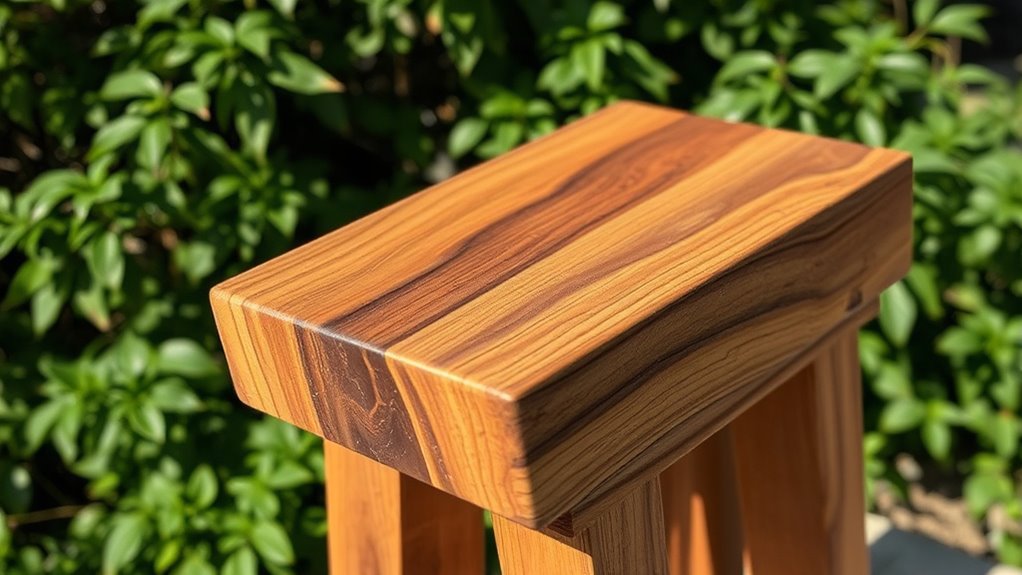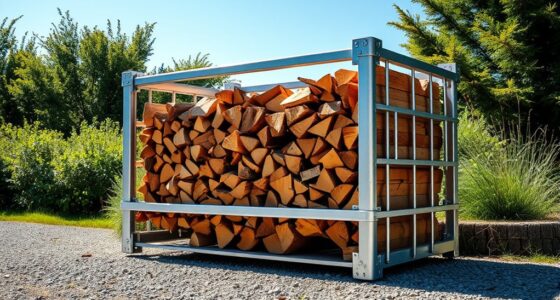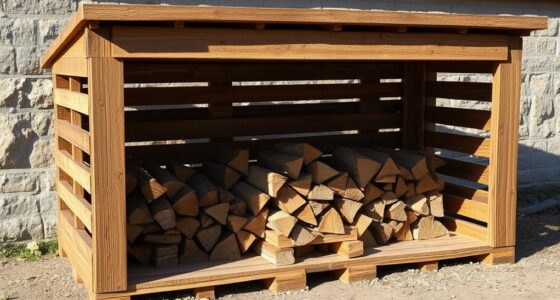To guarantee comfort and safety, your outdoor chopping block should be set to a height that allows your elbows to bend at about 90°, typically around waist level. Choose a sturdy, weather-resistant surface like hardwood or composite, with features like storage or drainage for better workflow. Proper design and material selection improve durability and ease of use outdoors. Keep in mind that the right height and material can make chopping more efficient—discover how to optimize your setup further.
Key Takeaways
- Aim for a chopping block height that allows elbow bends at approximately 90° for ergonomic outdoor food prep.
- Choose a durable, weather-resistant surface material like hardwood or treated wood to withstand outdoor conditions.
- Consider the shape and features, such as juice grooves or storage compartments, to enhance functionality and workflow.
- Regularly clean and treat the surface with food-safe oils to maintain durability and prevent weather-related damage.
- Match the chopping block size and height to your stature and outdoor space for optimal comfort and efficiency.

Have you ever wondered how the height and design of your chopping block can impact your kitchen workflow? When it comes to outdoor chopping blocks, these factors are especially important because they influence your comfort, efficiency, and safety while preparing meals or handling outdoor ingredients. Choosing the right height isn’t just about personal preference; it’s about optimizing your workspace for ease and ergonomics. The first thing to consider is how your chopping block’s height aligns with your own stature and the way you work. If it’s too low, you might strain your back or shoulders; if it’s too high, your arms could become fatigued. Ideally, your chopping surface should be at a height where your elbows are bent at about a 90-degree angle when you’re chopping. This makes your work more comfortable and reduces fatigue during extended use.
Design plays a critical role in how effectively you can work on your outdoor chopping block. Think about the shape—whether rectangular, round, or custom-shaped—to match your space and preferences. A well-designed outdoor chopping block often features a flat, sturdy surface that can handle heavy-duty cutting without wobbling. Some models incorporate features like integrated grooves for juice collection or storage compartments for utensils and tools, which can streamline your workflow outdoors. Additionally, the surface material impacts not just aesthetics but how well the chopping block withstands outdoor elements and daily use. Furthermore, understanding the contrast ratio of your outdoor chopping block surface can help ensure visibility and ease of use under various lighting conditions, especially if you work in shaded or outdoor environments.
Speaking of materials, their selection is essential for durability and ease of maintenance. Popular options include hardwoods like maple or oak, which are dense, durable, and resistant to splitting, making them ideal for outdoor use. Composite materials and treated woods can also offer enhanced weather resistance. When choosing materials, think about how they’ll hold up against moisture, temperature changes, and exposure to the elements. Proper maintenance tips will help you keep your outdoor chopping block in top shape. Regularly clean the surface with warm water and mild soap, and avoid harsh chemicals that could damage the material. Applying food-safe mineral oil or beeswax periodically can help protect the wood from moisture and prevent cracking or warping. If your chopping block is made from composite or treated wood, follow manufacturer guidelines for cleaning and upkeep to extend its lifespan.
Frequently Asked Questions
What Materials Are Best for Outdoor Chopping Blocks?
You should choose dense, durable woods like teak, ipe, or acacia for outdoor chopping blocks. These materials resist weather, rot, and insect damage, ensuring longevity. Wood durability is key, so avoid softer woods that wear quickly. Additionally, consider material maintenance—regular oiling helps preserve the wood’s surface and appearance. By selecting the right materials and maintaining them properly, your outdoor chopping block will stay functional and attractive for years.
How Weather-Resistant Are Different Chopping Block Designs?
Different chopping block designs vary in weather resistance based on material selection and construction. Wooden blocks with treated, dense hardwoods offer good weather durability if properly sealed and maintained, but they still need protection from prolonged moisture. Concrete or composite materials generally provide superior weather resistance, resisting moisture, cracking, and warping. You should choose a design that prioritizes material durability and includes protective finishes to guarantee your outdoor chopping block withstands the elements over time.
Can I Customize the Height of My Outdoor Chopping Block?
You absolutely can customize the height of your outdoor chopping block! With some DIY effort, you can tailor it to be the perfect height, making chopping feel effortless and comfortable. Think of it as your chance to blend practicality with aesthetic considerations—creating a stunning outdoor centerpiece that’s both functional and beautiful. So, go ahead, tweak that height, and craft a chopping block that’s uniquely yours!
What Safety Features Should I Consider in Design?
You should prioritize safety features like child safety locks and slip-resistant surfaces when designing your outdoor chopping block. Guarantee edges are smooth to prevent cuts, and consider adding a raised lip to contain debris. Child safety is vital, so avoid sharp corners and unstable bases. Slip resistance helps prevent accidents, especially when the surface gets wet. Incorporate these features to make your chopping block safer for everyone.
How Do I Maintain and Clean Outdoor Chopping Blocks?
Ever wondered how to keep your outdoor chopping block pristine and pest-free? You should regularly clean it with a mixture of warm water and mild soap, then dry thoroughly to prevent mold. Apply food-safe mineral oil to preserve the wood and maintain its appearance, enhancing your garden aesthetics. Proper maintenance prevents pests from nesting, ensuring your outdoor space stays safe, clean, and inviting for all your culinary adventures.
Conclusion
Choosing the right outdoor chopping block isn’t just about height and design—it’s about creating a space that invites you to work comfortably and confidently. When you pick a well-suited piece, every chop feels just a bit easier, and your outdoor workspace becomes a sanctuary of productivity and peace. Trust your instincts, and let the perfect chopping block subtly elevate your outdoor experience, turning simple tasks into moments of quiet satisfaction.









